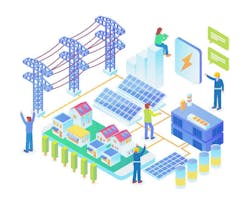Questioning the legality of utility-owned microgrids, regulatory advisors in Maryland on Friday came out against a microgrid pilot plan by Baltimore Gas & Electric.
By naulicreative/Shutterstock.com
Instead, the staff of the Maryland Public Service Commission (PSC) called for the commission to launch a larger, generic proceeding on microgrid policy in the state.
The staff recommendation was in response to an application BGE submitted in December to develop two public purpose microgrids with a capacity of 2-3 MW each. The utility wants to recover the microgrid costs, $16.2 million for the pair, through a special ratepayer charge.
The proceeding raises a key question that has been percolating in other restructured states. Can utilities develop and own microgrids in states where they are largely precluded by law from owning generation for competitive reasons? And can they recover the costs from ratepayers?
In its report submitted to the PSC, the commission staff said it’s not persuaded that “a utility-owned microgrid is legal, let alone that it is of sufficient public benefit to warrant ratepayer financing.”
As public purpose microgrids, the projects would serve as places of refuge for community members to get medical care, food and fuel, charge phones, and secure other services that require electricity. Public purpose microgrids (aka community microgrids) differ from private microgrids in that they offer services to the larger community.
Exelon, BGE’s parent, contends that it’s appropriate for utilities to build public purpose microgrids, and recover their costs from ratepayers, because they serve a larger public good. The energy company has other public purpose microgrid projects underway through utility subsidiaries in Illinois and Pennsylvania.
BGE proposed its microgrid plan in response to a 2014 state task force report produced under then Gov. Martin O’Malley, which encouraged the idea of utility ownership of public purpose microgrids. The task force report contended that Maryland law does allow utility-owned microgrids.
NRG against utility-owned microgrids in Maryland
But the PSC staff advised against the utility plan last week after reviewing comments submitted since February to the commission by several parties, among them the Microgrid Resources Coalition (MRC) and a group that included NRG Energy, Sun Edison and IGS Energy.
The NRG Energy group said that allowing utility-owned microgrids would undercut development of a competitive microgrid industry.
The group also sees utility-owned microgrids intruding on Maryland’s existing competitive retail supply market, since customers who need microgrids also tend to actively shop for power, rather than buy from the utility. Receiving their energy from a utility-owned microgrid would take these customers — hospitals, banks and other large energy users — out of the retail market, according to the group.
Meanwhile, the MRC took no stand on the BGE proposal, saying it is neutral on the matter of utility ownership of microgrids. The advocacy group instead called for the PSC to open a separate docket to address broad microgrid policies for the state.
Similarly, last week’s staff report also called for a broader look at microgrid policy; it suggested that this may be accomplished in upcoming ‘grid of the future proceedings’ planned in Maryland.
Microgrids vs back-up generation
BGE, an Exelon subsidiary, proposed the projects late last year as way to test microgrids that can avert outages in a crisis.
But even here the staff filing questioned the BGE project, saying study is needed on whether it might be more cost-effective to install back-up generators than microgrids.
Microgrids offer broader services than just back-up generation – as the MRC pointed out in its filing.
“In order to achieve widespread resiliency benefits at the lowest cost, Maryland should take advantage of all of the functions of microgrids,” MRC said.
In addition to providing, back-up power, microgrids can bolster the central grid and secure revenue by providing ancillary and other grid services. In some cases, microgrids can supply heat as well as electricity to their customers. And microgrids can help regions meet carbon and environmental goals.
“While resiliency is a primary benefit provided by microgrids, the MRC believes that an exclusive focus on this benefit actually limits the ability of microgrids to achieve resiliency goals and fails to recognize that a microgrid undertaken solely for resiliency purposes is unlikely to be self-funding in any meaningful way,” said MRC. “The economic, resiliency and environmental benefits of microgrids are mutually reinforcing.”
Others expressed support for the BGE microgrids, among them Baltimore Mayor Stephanie Rawlings-Blake and state lawmakers that represent areas where the microgrids would be built.
The commission is expected to rule on the utility proposal by July 30. Hearings are scheduled June 9 and 10 in Maryland.
Do you think utilities should be allowed to own microgrids — or should they be developed solely by the competitive players? Post your comments below or on the Microgrid Knowledge LinkedIn group.







